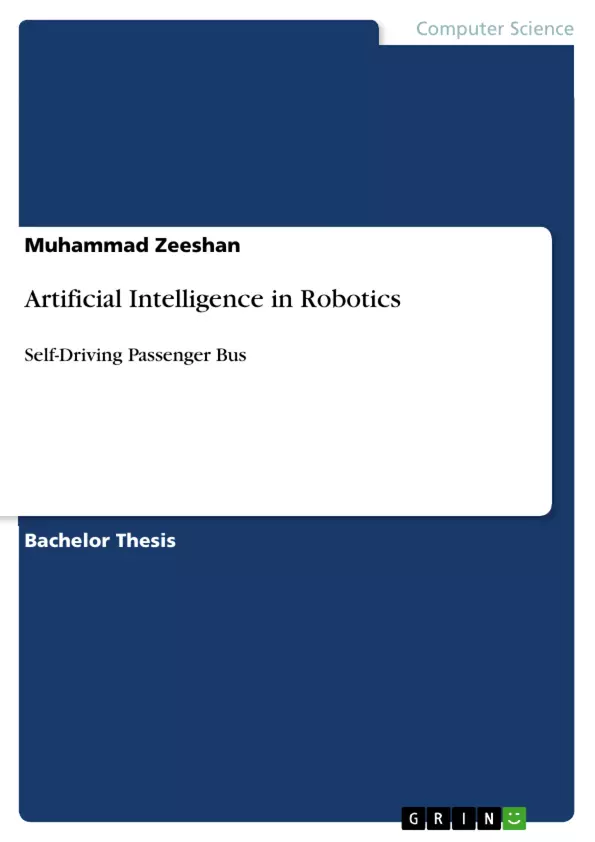In this text the basics of Artificial Intelligence will be described. The author will give an introduction to Artificial Intelligence, the history of Artificial Intelligence, where is Artificial Intelligence now and what other countries are doing and have done or plan doing Artificial Intelligence in the future.
Artificial Intelligence is the study to make those computers which can bear the actions normally associated with humans. The fundamental intention is to make computer more intelligent to work better and faster. If a computer can act like a baby of 3 years, we can say that computer is Artificial Intelligent. Artificial Intelligence is a multidisciplinary field which aims to make automation. I worked in Artificial Intelligence for Robotics in my thesis.
Robots are challenged to deal with natural intelligence of humans using the Artificial Intelligence. Robotics is a combine effort of Electronics, Mechanical effort and Computer and Artificial Intelligence have vital importance in each. Robotics and Artificial Intelligence intercommunicate for gaining intelligent systems which leads us to futuristic visions of compassionate intelligent devices. The wide uses of robotics are based on locomotion for the purpose of movement. It is very necessary for a machine to move from its position by wheels, legs or by swimming or flying to complete its task in sense of carrying matter or changing position for placing documents.
Table of Contents
- Chapter 1
- Introduction
- History
- Artificial Intelligence Now
- Artificial Intelligence and World
- Australia
- Canada
- China
- Denmark
- European Union
- Finland
- France
- Germany
- India
- Italy
- Japan
- Kenya
- Mexico
- New Zealand
- Nordic-Baltic Region
- Singapore
- South Korea
- Sweden
- Taiwan
- Tunisia
- UAE
- United Kingdom
- United States
- Who is Winning the race?
- Artificial Intelligence and Pakistan
- Word of Caution
- Chapter 2
- Literature review
- Chapter 3
- Robotics
- Robot
- History
- Why robotics?
- Social Implications
- Teleoperation
- Telepresence
- Chapter 4
- Intelligent Agents
- Environment
- Fully observable vs Partially observable
- Deterministic vs Stochastic
- Episodic vs Sequential
- Static vs Dynamic
- Single Agent vs Multi Agents
- Known vs Unknown
- Agent
- Composition of Agent
- Well-behaved agents
- Types of agents
- Agents Organizations
- Atomic Representation
- Search Agents
- Problem Solving as Search
- Problem Formulation
- State Space and Search Space
- State Space
- Search Space
- Chapter 5
- Adversarial Search and Games
- Games
- Perfect Information
- Imperfect Information
- Deterministic Games
- Non-Deterministic Games
- Zero Sum Games
- Embedded thinking
- Single Player
- MINIMAX Search Algorithm
- Expectiminimax
- Chapter 6
- Machine Learning
- Data Science
- Data science Process
- Applications of Machine Learning
- Interdisciplinary Field
- Unsupervised vs Supervised Learning
- Unsupervised Learning
- Semi Supervised Learning
- Supervised Learning
- Regression
- Linear Regression
- K-Nearest Neighbor Algorithm
- Chapter 7
- Self-Driving Passenger Bus
- Artificial Intelligence and Self-Driving cars
- History
- Basic Design and Principle
- Component
- Block Diagram
- Input System
- Infrared Sensors
- Comparator
- Ultrasonic sensors
- Passive Infrared Sensor
Objectives and Key Themes
This thesis aims to provide a comprehensive review of the current state of artificial intelligence (AI) in robotics. It explores the historical development of both AI and robotics, their respective applications in various domains, and the potential societal implications of their convergence.
- The historical development and current state of AI and robotics.
- The role of AI in modern robotics, with specific examples of its application.
- The societal implications of AI-powered robotics, including ethical considerations.
- The impact of AI in different countries and regions around the world.
- Challenges and opportunities for the future of AI in robotics.
Chapter Summaries
Chapter 1 introduces the concept of artificial intelligence (AI) and its historical evolution. It then delves into the present state of AI globally, examining its development and impact in various countries. The chapter concludes with a focus on AI in Pakistan and a word of caution regarding its potential implications.
Chapter 2 provides a literature review on the subject of AI in robotics. It summarizes relevant research studies and publications, offering a foundation for the subsequent analysis.
Chapter 3 delves into the field of robotics, defining a robot and outlining its historical evolution. It discusses the reasons for the increasing use of robotics, including their societal implications, and explores the concepts of teleoperation and telepresence in robotics.
Chapter 4 introduces the concept of intelligent agents, exploring their role in robotics and the various environments in which they operate. The chapter outlines different types of agents and their organizations, including search agents and their application in problem-solving.
Chapter 5 focuses on adversarial search and its application in game playing. It analyzes different types of games and the strategies employed in game-playing AI, including minimax search and expectiminimax algorithms.
Chapter 6 explores the field of machine learning, its application in robotics, and the various data science techniques utilized. The chapter delves into supervised and unsupervised learning methods, including regression and K-nearest neighbor algorithms.
Keywords
The key keywords and focus topics of this thesis include artificial intelligence (AI), robotics, machine learning, intelligent agents, adversarial search, game playing, data science, teleoperation, telepresence, and societal implications.
- Citation du texte
- Muhammad Zeeshan (Auteur), 2018, Artificial Intelligence in Robotics, Munich, GRIN Verlag, https://www.grin.com/document/495721



